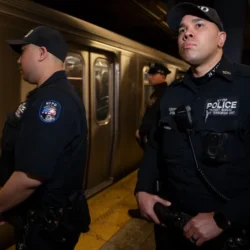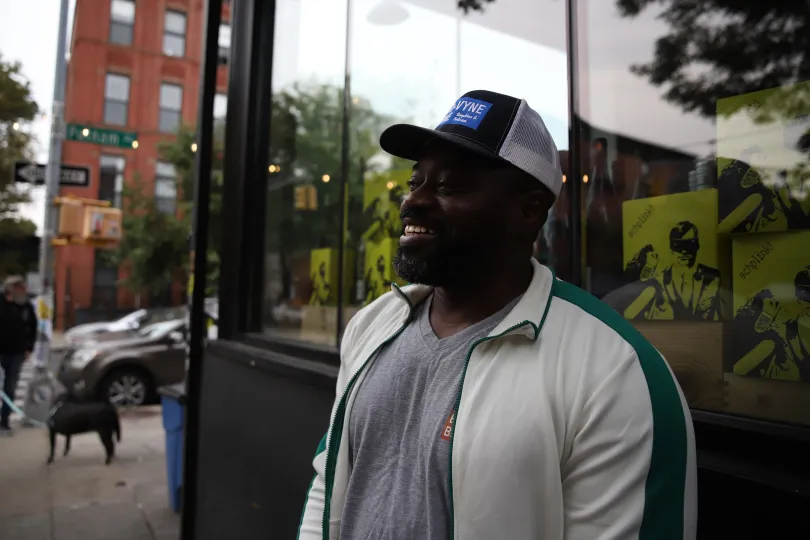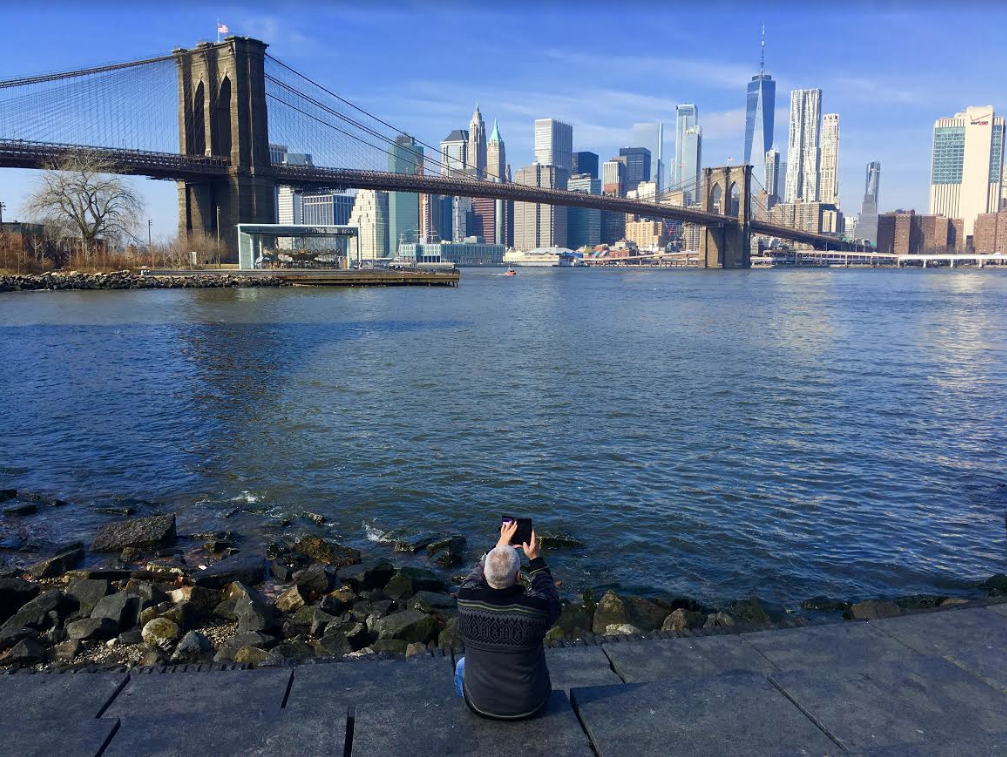
Is North Brooklyn the Future of New York City?
The economic success of DUMBO, the Navy Yard, Bushwick and Bed-Stuy points to possible paths for further economic growth outside Manhattan.

 This article was originally published on by THE CITY
This article was originally published on by THE CITY
At the Brooklyn Navy Yard, Taras Kravtchouk’s small workshop has produced 20 electric motorcycles made from recycled materials and hopes to manufacture 200 more over the next year before his company Tarform moves into mass production.
Blocks away, 180 designers at BIG NYC are working on urban projects — including how to rebuild the Brooklyn-Queens Expressway — spread over a wide open floor at the historic 45 Main Street building. Virtually all of the designers live in Brooklyn and many walk or bike to the office year round.
“There are naturally occurring retirement communities. This is a naturally occurring economic community,” said David Lombino, managing director of Two Trees Management Co., which is primarily responsible for the revival of DUMBO.
Before the pandemic, the area saw the highest rates of small business formation in the city between 2018 and 2019 with the addition of 1,300 new firms, according to a study released in May by the city Economic Development Corporation. These neighborhoods also showed the highest growth in new small firms between in 2021 and early 2022 as the city recovered from the pandemic, led by professional services, tech and consumer businesses, especially restaurants.
“These professional and consumer service sectors reflect the transformation of northern Brooklyn into a hub of entrepreneurship,” said the report.
/cdn.vox-cdn.com/uploads/chorus_asset/file/24944368/092223_tarform_6.jpg)
The success of north Brooklyn was not preordained. Two decades ago, it appeared to be like so many other Rust Belt zones in the Northeast and Midwest that had been manufacturing hubs in the first half of the 20th century.
What was different was that Brooklyn had a brand, even if that was tarnished by crime and urban decay. “People knew where Brooklyn was,” said Randy Peers, president of the Brooklyn Chamber of Commerce and a longtime executive at nonprofits in the borough. “What we needed to do was rebrand it and start talking about ourselves. And dangerous became edgy, and now hip.”
More important was the enormous amount of abandoned or underutilized industrial space that could be repurposed as housing or live/work space to attract people and the redevelopment of other space for new companies in the so-called creative economy — tech, advertising, marketing, and some new, smaller scale modern manufacturing companies.
Nowhere is the transformation more evident than at the Navy Yard, which the city gained control of in 1968 as part of a deal where the Nixon administration transferred the area to the city after then Mayor John Lindsay nominated Spiro Agnew for vice-president rather than contest his nomination at the Republican convention.
The Navy Yard, which had employed 75,000 workers building and repairing ships during World War II, languished for decades as a captive of the Brooklyn Democratic Party machine. Early in the administration of Mayor Mike Bloomberg, Deputy Mayor Dan Doctoroff took control of the facility and began its transformation.
Today, the Navy Yard is home to 550 industrial and commercial businesses, a third of which are owned by people of color and in all employ 11,000 people. While the biggest tenant is the sprawling Steiner Studios film operation, the average company size is only 12 employees.
/cdn.vox-cdn.com/uploads/chorus_asset/file/24944329/092223_tarform_1.jpg)
“We are building a machine out of nothing here in New York City,” Kravtchouk said. “We are in the middle of a great community of tech and craftsmanship.”
They also get to test the bikes by rising around the Yard and use their space as a showroom.
Companies pursuing climate change have emerged as a key component of the yard and they are being joined by a series of biotech startups, says CEO Lindsay Greene, who this month released a request for proposals to design a new building as large as 1 million square feet for industrial companies.
From Waterfront to Wine
If the Bloomberg administration gets credit for the Navy Yard, the rebirth of DUMBO was the product of one developer, David Walentas. He bought all the buildings in the industrial neighborhood in 1979, pushed for it to be rezoned to allow for conversion to residential use, redeveloped most of the structures into hip loft spaces less expensive than those in Manhattan and preserved 1.5 million square feet of office space.
More than 1,000 small companies fill those buildings, along with 150 artist studios. An office building at 10 Jay Street opened just before the pandemic and is now filled, according to the DUMBO business improvement district.
If the new wisdom is that the future belongs to live/work areas, DUMBO has long traded on that proposition. BIG NYC is a New York arm of a Denmark company and opened its New York office 13 years ago in Chelsea before moving to and outgrowing its space in the Financial District.
“We wanted more space to collaborate, and we looked around and realized 80% of our designers worked in Brooklyn,” said Allison Wicks, business development director. She lives in Clinton Hill and enjoys her daily 45-minute walk to work through the borough.
/cdn.vox-cdn.com/uploads/chorus_asset/file/24944533/091523_BIG10_Krales_edit.jpg)
In addition to professional service firms like BIG, DUMBO and other parts of north Brooklyn have become second only to Manhattan as a home to tech companies. The most prominent is the online craft platform Etsy, whose stock is worth almost $8 billion. In all, tech jobs in Brooklyn jumped 42% to 14,000 between 2012 and 2021, according to a report by the trade group Tech:NYC.
Meanwhile, retail and small commercial businesses have flocked to Bed-Stuy to take advantage of a residential construction boom that has made it the poster child for a gentrifying neighborhood for the past two decades.
But many established retailers like Bed-Vyne have thrived as well.
The wine store sells small family-owned wine producers and its own private-label roster of 20 varieties that cost between $9.99 and $16.99, says Akinnuoye. The key to their success has been community involvement, especially the Tompkins Avenue Open Streets Sundays that attract thousands of people in the spring and summer.
It may be the most successful Open Streets event in the city, with online clicks reaching 300,000 some weeks, says Blondel Pinnock, president of the Bedford Stuyvesant Restoration Corp., the local development group charged with improving what was once a depressed neighborhood.
/cdn.vox-cdn.com/uploads/chorus_asset/file/24947314/092223_TompkinsAve5_Krales_edit.jpg)
What she sees is a diverse neighborhood but one that remains primarily the home of Black New Yorkers. Her organization is planning a major transformation of its home at Restoration Plaza with two large new buildings, one as high as 16 stories, and four smaller ones to create 840,000 square feet of office and cultural space.
“We want this to be the center of Black wealth creation, black job creation and the tech center of this part of Brooklyn,” she said.
‘The Virtuous Cycle’
North Brooklyn has not been untouched by the economic changes brought by pandemic — especially the diminished outlook for office space. Dock 72, a 675,000 square foot new office building opened at the Navy Yard in 2019 is only about 40% leased. One of its major tenants is WeWork, the coworking space company that is in bankruptcy and is renegotiating or abandoning leases. Codevelopers Boston Properties and Rudin Management declined to discuss their slow pace of leasing.
And there are limitations as companies grow. If Tarform is successful enough to move to mass production, the factory it will build will be elsewhere, probably California, Texas or North Carolina, Kravtchouk says.
The question for the city is whether the success of North Brooklyn can be replicated elsewhere in the city, the key recommendation of the New New York Report issued in December 2022 by a panel commissioned by both Mayor Eric Adams and Gov. Kathy Hochul.
Doctoroff, the Bloomberg administration deputy mayor who was co-chair and the driving force behind the report, says the answer is clearly yes — and points to growth in Long Island City in Queens and the transformation of the South Bronx with the construction of thousands of new residential units.
Much of that is the result of the five-borough economic strategy of the Bloomberg administration, he adds. The Adams administration is moving to further those gains with its City of Yes program to boost businesses and housing, plans to make the city the global hub of urban innovation, and an emphasis on capital projects outside Manhattan.
“It is a strategy rooted in the notion of the virtuous cycle. More people in the city, more jobs, more visitors, all of which produces more tax revenues and to be invested back in improving quality of life, which then draws more people,” he said.
THE CITY is an independent, nonprofit news outlet dedicated to hard-hitting reporting that serves the people of New York.
Leave a Comment
Related Articles


The Ground Is Collapsing Under Canarsie Homes and Nobody Is Sure How Many Are Affected

Loud Loo? Park Dwellers Want City to Pay for Quieter Public Bathroom
Leave a Comment

Northern Brooklyn
View MoreThe Brooklyn Daily Eagle and brooklyneagle.com cover Brooklyn 24/7 online and five days a week in print with the motto, “All Brooklyn All the Time.” With a history dating back to 1841, the Eagle is New York City’s only daily devoted exclusively to Brooklyn.
© 2024 Everything Brooklyn Media
https://brooklyneagle.com/articles/2023/09/27/is-north-brooklyn-the-future-of-new-york-city/
